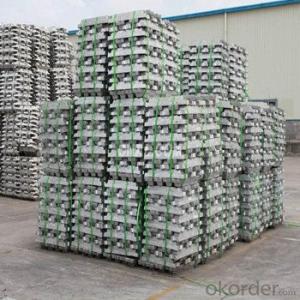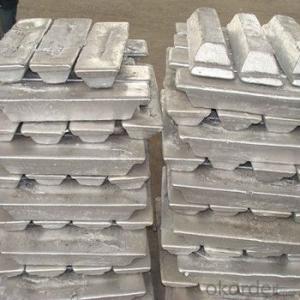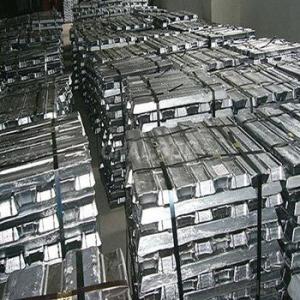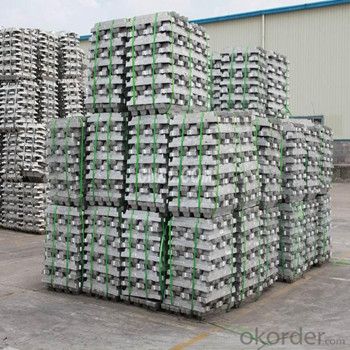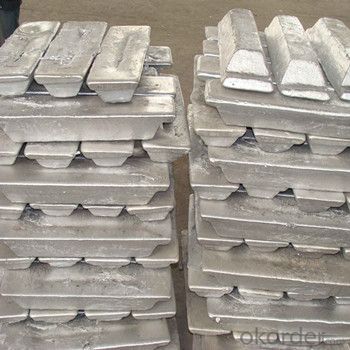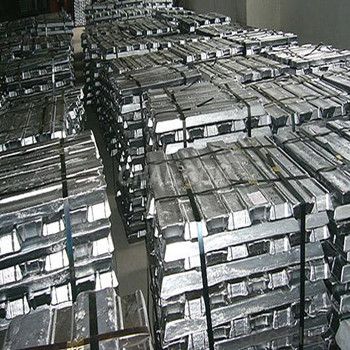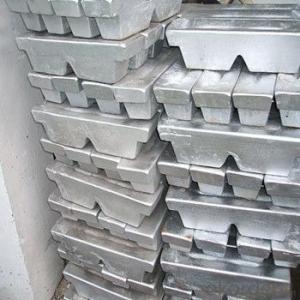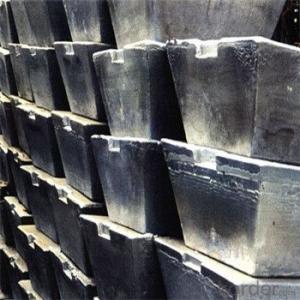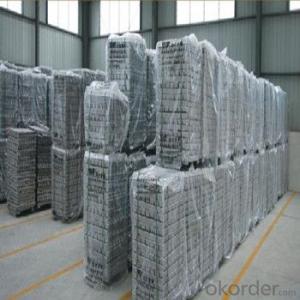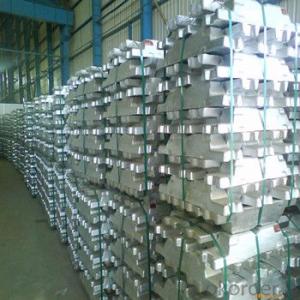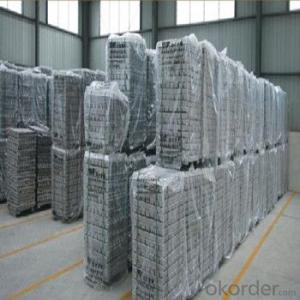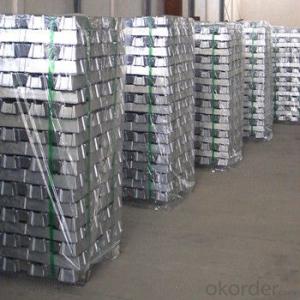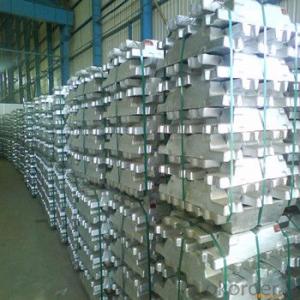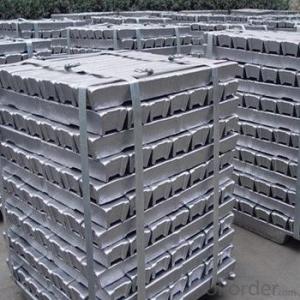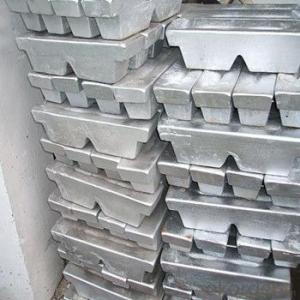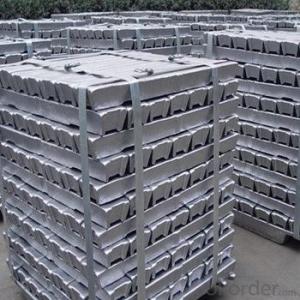Aluminum Pig/Ingot Used For Industry From China
- Loading Port:
- China main port
- Payment Terms:
- TT OR LC
- Min Order Qty:
- 1000 m.t.
- Supply Capability:
- 100000 m.t./month
OKorder Service Pledge
OKorder Financial Service
You Might Also Like
Pure Aluminum Pig/Ingot Used for Industry
1.Structure of Aluminum Pig/Ingot
A material that has been cast into a shape in order to be transported and processed easier than in an unprocessed form. An ingot is typically rectangular in shape, which allows it to be stacked. Ingots are most commonly associated with metals, with ingots of gold held in the vaults of banks and brokerages being popular images.
Aluminum Ingot is with the AL as the main chemical composition.Aluminum Ingot is used for industry,such as automobile,pinning and weaving,electron broadly and so on. Aluminum Ingot has the following advantages: easy control and operation, fast melting.
2.Main Features of the Aluminum Pig/Ingot
•High Purity
•Easy control and operation
•High strength
•Fast melting
•Competitive price
•Best Service
3.Aluminum Pig/Ingot Images
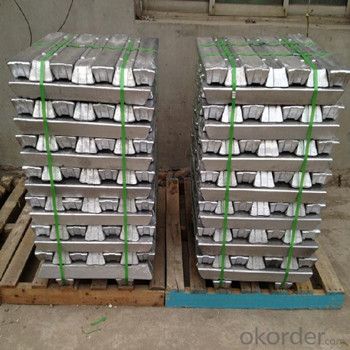
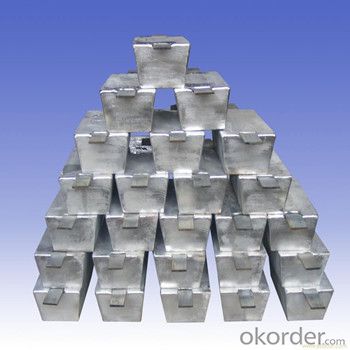
4.Aluminum Pig/Ingot Specification
Grade | Chemical Composition % | |||||||||
Al≥ | impurities ≤ | |||||||||
Si | Fe | Cu | Ga | Mg | Zn | Mn | others | Sum | ||
Al99.9 | 99.90 | 0.50 | 0.07 | 0.005 | 0.02 | 0.01 | 0.025 | - | 0.010 | 0.10 |
Al99.85 | 99.85 | 0.80 | 0.12 | 0.005 | 0.03 | 0.02 | 0.030 | - | 0.015 | 0.15 |
Al99.7 | 99.70 | 0.10 | 0.20 | 0.010 | 0.03 | 0.02 | 0.030 | - | 0.030 | 0.30 |
Al99.6 | 99.60 | 0.16 | 0.25 | 0.010 | 0.03 | 0.03 | 0.030 | - | 0.030 | 0.40 |
Al99.5 | 99.50 | 0.22 | 0.30 | 0.020 | 0.03 | 0.05 | 0.050 | - | 0.030 | 0.50 |
Al99.00 | 99.00 | 0.42 | 0.50 | 0.020 | 0.03 | 0.05 | 0.050 | - | 0.050 | 1.00 |
5.FAQ of Aluminum Pig/Ingot
We have organized several common questions for our clients,may help you sincerely:
①How about your company?
A reliable manufacturer & supplier of Aluminum Pig/Ingot,with many years’ experience in producing Aluminum Pig/Ingot.The items have beedn exported around the world,and have been acceptable among the customers,and have gotten the good reputation already.No matter from the quality,price and service,can be guaranteed for the cusgtomers.High purity and diffent grade are available.
②How to guarantee the quality of the products?
We have established the international advanced quality management system,every link from raw material to final product we have strict quality test;We resolutely put an end to unqualified products flowing into the market. At the same time, we will provide necessary follow-up service assurance.
③How long can we receive the product after purchase?
In the purchase of product within three wo We have organized several common questions for our clients,may help you sincerely:
- Q: What are the environmental impacts of producing aluminum ingots?
- The production of aluminum ingots has various environmental impacts. One of the main concerns is the extraction of bauxite, the primary ore used to produce aluminum. Mining for bauxite often involves deforestation and habitat destruction, leading to the loss of biodiversity and disruptions to ecosystems. The process of refining bauxite into alumina, a precursor to aluminum, requires significant amounts of energy. This energy is typically generated from non-renewable sources such as coal or natural gas, resulting in greenhouse gas emissions and contributing to climate change. Electrolysis is then used to convert alumina into aluminum metal, which requires large amounts of electricity. If this electricity is generated from fossil fuel-based power plants, it further contributes to greenhouse gas emissions. However, some aluminum smelters are transitioning to renewable energy sources, which can help reduce their carbon footprint. The production of aluminum ingots also generates waste and by-products. The red mud, a residue left after extracting alumina, is highly alkaline and can pose risks to soil and water quality if not properly managed. It can also have harmful effects on aquatic life if it enters nearby water bodies. Additionally, the transportation of bauxite, alumina, and aluminum ingots over long distances contributes to carbon emissions and air pollution. The extraction and production processes may also require the use of chemicals and other resources that can have negative impacts on local ecosystems and water sources if not properly managed. In conclusion, the production of aluminum ingots has several environmental impacts, including deforestation, greenhouse gas emissions, waste generation, and potential pollution of water and soil. However, the industry is making efforts to mitigate these impacts through renewable energy adoption, improved waste management practices, and resource efficiency measures.
- Q: How are aluminum ingots used in the production of modular buildings?
- Aluminum ingots play a crucial role in the production of modular buildings due to their unique characteristics and properties. These ingots are first melted and then transformed into various components, such as beams, columns, panels, and other structural elements, that are used to construct the modular units. One of the main advantages of aluminum is its lightweight nature, making it an ideal choice for modular construction. Aluminum ingots are much lighter than steel, yet they offer excellent strength-to-weight ratio, ensuring the durability and stability of the modular building. This lightweight characteristic also allows for easier transportation and assembly of the modules, reducing the overall construction time and costs. Moreover, aluminum offers exceptional corrosion resistance, which is particularly beneficial for modular buildings that may be exposed to harsh weather conditions or coastal environments. This resistance to corrosion ensures that the building will maintain its structural integrity and aesthetics for a longer period of time, reducing maintenance and repair costs. Aluminum ingots are also highly versatile and can be easily molded and shaped into various forms and sizes. This flexibility allows architects and designers to create innovative and customized modular building designs, meeting different functional and aesthetic requirements. Additionally, aluminum can be easily recycled, making it a sustainable choice for modular construction projects, aligning with the growing demand for environmentally friendly and energy-efficient buildings. In conclusion, aluminum ingots are used in the production of modular buildings due to their lightweight, corrosion-resistant, versatile, and sustainable properties. These ingots are transformed into various components that provide strength, durability, and flexibility to the modular units, facilitating faster construction, reducing costs, and ensuring long-term performance.
- Q: Could you tell me how to calculate the value of aluminum material? By weight or by length or by other means?
- According to the weight calculation, international trade every day aluminum prices refresh, at this stage in 17 thousand tons, finished to calculate the cost of processing, such as: Aluminum Alloy window, this is an aluminum extrusion, extrusion processing costs to add 4500 tons.
- Q: What are the properties of aluminum ingots?
- Aluminum ingots possess several distinct properties that make them highly valuable in various industries. First and foremost, aluminum ingots exhibit exceptional lightness, as they have a low density compared to other metals. This property makes them ideal for applications where weight reduction is crucial, such as in the aerospace and automotive sectors. Additionally, aluminum ingots possess excellent corrosion resistance, making them suitable for use in environments where exposure to moisture, chemicals, or harsh weather conditions is probable. This corrosion resistance is due to the formation of a thin, protective oxide layer on the surface of the ingot, which prevents further oxidation and deterioration. Another notable property of aluminum ingots is their high thermal conductivity, allowing them to efficiently transfer heat. This characteristic is particularly advantageous in heat exchange systems, where the ingots can facilitate the transfer of thermal energy. Moreover, aluminum ingots also exhibit excellent electrical conductivity, making them suitable for applications in the electrical and electronics industries. Furthermore, aluminum ingots have a high strength-to-weight ratio, making them strong yet lightweight. This property allows for the construction of structures that require both strength and durability without compromising on weight. Moreover, aluminum ingots are easily recyclable, retaining their properties even after multiple recycling processes, which makes them an environmentally friendly choice. Overall, the properties of aluminum ingots, including their lightness, corrosion resistance, thermal and electrical conductivity, high strength-to-weight ratio, and recyclability, contribute to their widespread use in various industries, ranging from transportation and construction to packaging and consumer goods.
- Q: Can aluminum ingots be used in 3D printing?
- Yes, aluminum ingots can be used in 3D printing. Aluminum is a commonly used material in additive manufacturing due to its lightweight, high strength, and excellent thermal conductivity. However, instead of directly using aluminum ingots, a process called powder bed fusion, specifically selective laser melting (SLM) or electron beam melting (EBM), is utilized. In this process, fine aluminum powder is spread in thin layers and selectively melted by a laser or electron beam, layer by layer, to create the desired 3D object. This allows for the production of complex geometries and precise parts with high strength and accuracy.
- Q: Wall aluminum window price
- Now there are all aluminum furniture, aluminum materials, for more information, you can point me
- Q: What are the quality standards for aluminum ingots?
- The quality standards for aluminum ingots are defined by various organizations and regulatory bodies to ensure the production of high-quality and consistent aluminum products. The following are some of the common quality standards for aluminum ingots: 1. Chemical Composition: The chemical composition of aluminum ingots is crucial in determining its mechanical properties and suitability for specific applications. Quality standards outline the acceptable ranges for elements such as aluminum, iron, silicon, copper, magnesium, and other impurities. 2. Purity: Aluminum ingots should meet specific purity requirements to ensure minimal impurities and contaminants. Standards typically set limits for impurities like oxides, alkali metals, and heavy metals to maintain the desired quality. 3. Physical Properties: Quality standards also cover various physical properties, including density, tensile strength, elongation, hardness, and thermal conductivity. These properties determine the ingot's performance in different applications and help manufacturers produce consistent, reliable aluminum products. 4. Grain Structure: The grain structure of aluminum ingots influences their mechanical strength and formability. Quality standards define the acceptable grain size and uniformity to ensure consistent properties within the ingots. 5. Surface Quality: The surface of aluminum ingots should be free from defects like cracks, voids, porosity, or excessive oxidation. Quality standards specify the acceptable limits for these defects to ensure the ingots' suitability for further processing. 6. Dimensional Tolerances: Standards also define the acceptable dimensional tolerances for aluminum ingots, including length, width, thickness, and weight. These tolerances ensure uniformity and compatibility with downstream manufacturing processes. 7. Packaging and Marking: Quality standards often include guidelines for appropriate packaging and marking of aluminum ingots to prevent physical damage, corrosion, or mix-ups during transportation and storage. It is important to note that specific quality standards may vary depending on the industry and intended use of the aluminum ingots. Manufacturers and customers should refer to relevant standards organizations, such as the International Organization for Standardization (ISO) or the American Society for Testing and Materials (ASTM), to ensure compliance with the appropriate quality requirements.
- Q: What quality aluminium ingots can be made out of pop cans?
- In fact, the recycled aluminum slag can also be used for smelting aluminum ingots. But it doesn't work well. It needs stirring and a lot of slag. There is also a saying that the only way aluminum slag smelting aluminum ingot is electrolysis, the use of reduction method is too expensive
- Q: What is the role of aluminum ingots in the production of aircraft?
- Aluminum ingots play a crucial role in the production of aircraft as they are the primary raw material used in manufacturing various components, such as the fuselage, wings, and other structural parts. Due to its lightweight, high strength, and corrosion-resistant properties, aluminum is an ideal material for aircraft construction. The ingots are melted down and transformed into sheets, plates, and extrusions, which are then fabricated and assembled into the airframe. This versatile metal allows for weight reduction, increased fuel efficiency, and improved performance, making it an essential element in modern aircraft production.
- Q: What are the impurities found in aluminum ingots?
- Aluminum ingots, which are the primary raw material for various aluminum products, can contain several impurities. These impurities can be broadly classified into metallic, non-metallic, and gas impurities. Metallic impurities found in aluminum ingots include elements such as iron, silicon, copper, manganese, zinc, and magnesium. These impurities can originate from the raw materials used in the production process or from the equipment used during the melting and casting of the ingots. Metallic impurities can negatively impact the quality and performance of the final aluminum products, affecting their strength, corrosion resistance, and other mechanical properties. Non-metallic impurities in aluminum ingots consist of various compounds and particles, such as oxides, carbides, nitrides, and sulfides. These impurities can arise from the presence of oxygen, nitrogen, sulfur, or carbon in the production process. Non-metallic impurities can cause defects in the aluminum products, such as porosity, inclusions, or uneven microstructure, which can weaken the material and reduce its overall quality. Gas impurities are another type of impurity found in aluminum ingots. Common gases that can be present in the ingots include hydrogen, oxygen, nitrogen, and carbon monoxide. These gases can be introduced during the melting and casting process or can result from the interaction of the molten aluminum with the surrounding atmosphere. Gas impurities can lead to internal defects in the aluminum products, such as gas porosity or bubbles, which can impair their mechanical properties and appearance. To ensure the quality of aluminum ingots and the resulting aluminum products, rigorous quality control measures are employed throughout the production process. Various techniques, such as refining, degassing, and filtration, are employed to minimize the presence of impurities in the ingots. Additionally, thorough testing and analysis are performed to monitor and verify the impurity levels in the ingots, ensuring compliance with industry standards and customer requirements.
Send your message to us
Aluminum Pig/Ingot Used For Industry From China
- Loading Port:
- China main port
- Payment Terms:
- TT OR LC
- Min Order Qty:
- 1000 m.t.
- Supply Capability:
- 100000 m.t./month
OKorder Service Pledge
OKorder Financial Service
Similar products
Hot products
Hot Searches
